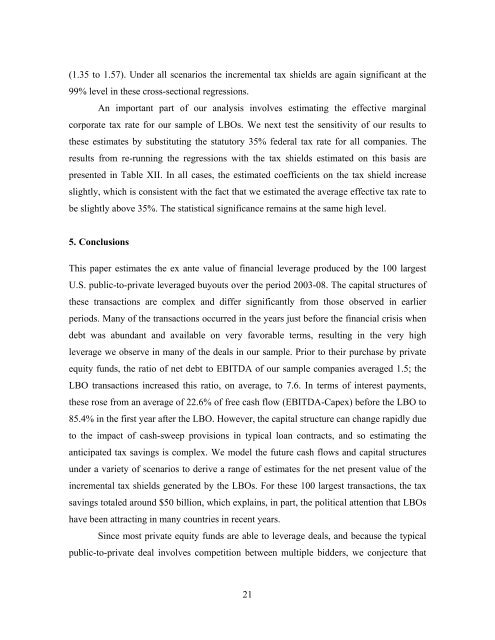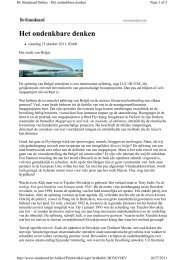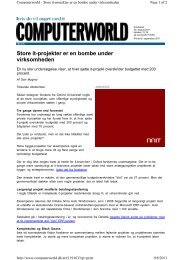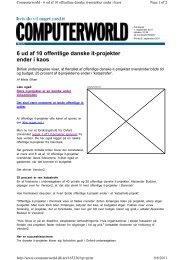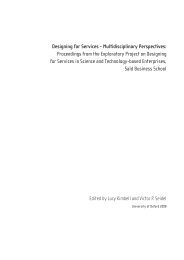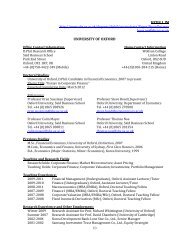Who benefits from the leverage in LBOs? - Said Business School ...
Who benefits from the leverage in LBOs? - Said Business School ...
Who benefits from the leverage in LBOs? - Said Business School ...
Create successful ePaper yourself
Turn your PDF publications into a flip-book with our unique Google optimized e-Paper software.
(1.35 to 1.57). Under all scenarios <strong>the</strong> <strong>in</strong>cremental tax shields are aga<strong>in</strong> significant at <strong>the</strong><br />
99% level <strong>in</strong> <strong>the</strong>se cross-sectional regressions.<br />
An important part of our analysis <strong>in</strong>volves estimat<strong>in</strong>g <strong>the</strong> effective marg<strong>in</strong>al<br />
corporate tax rate for our sample of <strong>LBOs</strong>. We next test <strong>the</strong> sensitivity of our results to<br />
<strong>the</strong>se estimates by substitut<strong>in</strong>g <strong>the</strong> statutory 35% federal tax rate for all companies. The<br />
results <strong>from</strong> re-runn<strong>in</strong>g <strong>the</strong> regressions with <strong>the</strong> tax shields estimated on this basis are<br />
presented <strong>in</strong> Table XII. In all cases, <strong>the</strong> estimated coefficients on <strong>the</strong> tax shield <strong>in</strong>crease<br />
slightly, which is consistent with <strong>the</strong> fact that we estimated <strong>the</strong> average effective tax rate to<br />
be slightly above 35%. The statistical significance rema<strong>in</strong>s at <strong>the</strong> same high level.<br />
5. Conclusions<br />
This paper estimates <strong>the</strong> ex ante value of f<strong>in</strong>ancial <strong>leverage</strong> produced by <strong>the</strong> 100 largest<br />
U.S. public-to-private <strong>leverage</strong>d buyouts over <strong>the</strong> period 2003-08. The capital structures of<br />
<strong>the</strong>se transactions are complex and differ significantly <strong>from</strong> those observed <strong>in</strong> earlier<br />
periods. Many of <strong>the</strong> transactions occurred <strong>in</strong> <strong>the</strong> years just before <strong>the</strong> f<strong>in</strong>ancial crisis when<br />
debt was abundant and available on very favorable terms, result<strong>in</strong>g <strong>in</strong> <strong>the</strong> very high<br />
<strong>leverage</strong> we observe <strong>in</strong> many of <strong>the</strong> deals <strong>in</strong> our sample. Prior to <strong>the</strong>ir purchase by private<br />
equity funds, <strong>the</strong> ratio of net debt to EBITDA of our sample companies averaged 1.5; <strong>the</strong><br />
LBO transactions <strong>in</strong>creased this ratio, on average, to 7.6. In terms of <strong>in</strong>terest payments,<br />
<strong>the</strong>se rose <strong>from</strong> an average of 22.6% of free cash flow (EBITDA-Capex) before <strong>the</strong> LBO to<br />
85.4% <strong>in</strong> <strong>the</strong> first year after <strong>the</strong> LBO. However, <strong>the</strong> capital structure can change rapidly due<br />
to <strong>the</strong> impact of cash-sweep provisions <strong>in</strong> typical loan contracts, and so estimat<strong>in</strong>g <strong>the</strong><br />
anticipated tax sav<strong>in</strong>gs is complex. We model <strong>the</strong> future cash flows and capital structures<br />
under a variety of scenarios to derive a range of estimates for <strong>the</strong> net present value of <strong>the</strong><br />
<strong>in</strong>cremental tax shields generated by <strong>the</strong> <strong>LBOs</strong>. For <strong>the</strong>se 100 largest transactions, <strong>the</strong> tax<br />
sav<strong>in</strong>gs totaled around $50 billion, which expla<strong>in</strong>s, <strong>in</strong> part, <strong>the</strong> political attention that <strong>LBOs</strong><br />
have been attract<strong>in</strong>g <strong>in</strong> many countries <strong>in</strong> recent years.<br />
S<strong>in</strong>ce most private equity funds are able to <strong>leverage</strong> deals, and because <strong>the</strong> typical<br />
public-to-private deal <strong>in</strong>volves competition between multiple bidders, we conjecture that<br />
21


